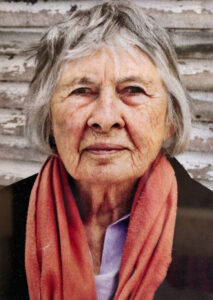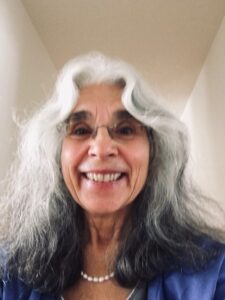A Time to Talk
When a friend calls to me from the road
And slows his horse to a meaning walk
I don’t stand still and look around
On all the hills I haven’t hoed,
And shout from where I am, “What is it?”
No, not as there is a time to talk.
I thrust my hoe in the mellow ground,
Blade-end up and five feet tall,
And plod: I go up to the stone wall
For a friendly visit.
–Robert Frost, from Mountain Interval, 1916
My father and mother were born in 1904 and 1916; both were raised in farming communities and small towns before they grew up to explore cosmopolitan places. Some of my earliest memories of poetry being said aloud were my father’s recitations of excerpts from Edwin Markham’s “Man with a Hoe” and Frost’s “Death of a Hired Man.” In their time, the memorization of passages by revered authors was part of the expected accomplishment of a literate person; storytelling itself was a studied art. Both parents made “a time to talk” to their neighbors, friends, family and even casual passersby in good measure. All these times of talk added to our rich store of narrative tales—spoken memoirs with truth telling and bent truths incorporated in inventive, reportorial, grave, ironic, wild and humorous forms.
Can we model the same kinds of literate exchanges with and for our students in this fractured time? What can we give and learn from the active cultivation of oral histories across disciplines?
Some of the most meaningful learning experiences I’ve witnessed have been interviews. They begin with an unquenchable need to know on the part of the interviewer. She has to listen, and to adapt to the subject’s sense of what is important in an experience. An interview fits with any learning quest, across all disciplines, and between people of all ages. Donald Graves believed in nurturing interview skills with children as young as seven; from young childhood on into elder-hood, we have the potential to make a time to talk part of an enduring, enriching approach to speaking, listening, writing and reading.
Could Donald Graves’ pioneering ideas about using interviews to augment our curricula be more current now than 35 years ago? There is much room for cultivating their use as tools for deepening students’ learning. The interview, translated as “seeing each other,” is a timeless art. We can take our cues from experts— Teri Gross, John Stewart, Stephen Colbert and Christiane Amanpour—and with a little coaching, we can help any person conduct an insightful interview. The interviewer needs to clear away preconceptions, to be open to the unexpected. At this time, when physical distancing is our new lingua franca, giving elders and youngsters more opportunities to share ideas, impressions and recollections can build community in significant ways—whether the subject is family, friend or neighbor, expert in a field or simply a person we want to know better.

My friend Jeanette Andrew, a progressive educator and fierce advocate for her students, was an innovator who, fifty years ago, was an ally of Donald Graves, Donald Murray and Ken McCrorie. Her mantra was “discovery.” She pushed her students to understand the ideas in writing from the deepest elements of selfhood. She believed students would discover their unique originality through this quest. Valuing each writer’s voice and the immediacy of their observations, she extolled telling writing. As one of the first proponents of personalized learning in Vermont in the1970s, she helped her students design community-based learning experiences. Interviewing, in the sense of seeing each other, was one of her bedrock principles, informing her teaching at the most profound level. Long retired, and well into her eighties, she began an interview project in her rural neighborhood, appearing unannounced at doorways, with the query “What is your passion?” as an introduction. Discovery is unbounded.
In the 20th century American Studies course I team taught, my partner and I asked students to interview citizens in the community about their recollections of various decades. We worked together with students to conduct interviews late in each unit of study, when the readings, projects and cultural studies of each era were well underway. We brainstormed questions as a whole group, then gave copies of the set to every student. An array of questions gave them many jumping off points for the interviews, and questions to fall back on if conversation stalled.
Helping students move beyond the bland Q and A form, brings descriptive skills, analysis and interpretation to the fore, as context and commentary require a less literal rendering of information. The interviewer must be ardent about both topic and interview subject.The teacher/mentor acts as guide if the student is unsure about the subject she wants to explore.
The most difficult aspect of interviewing to teach is how to listen and adapt one’s pace of questioning to the interview subject. It’s essential to collect strong student-produced models, as well as professional models, to show students. When my partner and I visited local assisted living facilities with our students, often the best interviews came out of small groups of students talking with one elder. Recording oral histories presents challenging demands for the writer—setting, character sketches, sequences and a memorable conclusion are all desired outcomes. A writing process approach with a succession of drafts before the final clean copy is produced, to be archived in the school library and given to the interview subject or his or her family, ensures that an authentic audience is valued. A mentor-teacher may coach the student learner at every stage so that the final record of the interview will be clear and interesting to a diverse audience. Students learn a great deal from interviews, whether they expect to or not; student writers frequently chose their interview pieces as examples of their best writing.
If students have the freedom to create their own direction for learning, they experience a powerful motivating force for shifting learning style from dependent to independent. Autotelic can be roughly translated as “self-goal,” or “self-contained.” We hope to inculcate this kind of feeling about learning in our students—a time to talk can boost teaching and learning in both concrete and ineffable ways.
In my life, striving for an autotelic learning experience has given me energy and impetus many times over. One of the most memorable of these was in the early 1970s when I was an undergraduate at the University of California, San Diego in La Jolla, California. Besides awe-inspiring scientists at Scripps Institute and the cosmopolitan array of humanists and artists at UCSD, there was a storied local surfing culture. I partnered with a classmate in an anthropology course to write about the surfing subculture in La Jolla. We composed a set of interview questions directed at revealing the distinctive nature of the subculture, and interviewed fifty surfers of various ages and stages of life. We carried out field work at beaches in La Jolla and made trips to surfing contests, surfing shops, surfing magazines and surfing movies.
Interviewing people who were part of the surfer subculture doubled our experience: the interview subjects epitomized an immersive experiential reality, and our work as interviewers mirrored that reality. Just as does surfing itself, original, subjective exploration embodies the spirit of autotelic experience and authentic learning.

The interviewing process demands action research, connection and personalization. We intend to promote all three for every learner in Vermont, and beyond. There is no limitation on its usefulness for any discipline a learner pursues, as is so clear when we look at any kind of journalism, long or short form. For a student who is not conventionally motivated, or who may have undeveloped speaking, listening, reading or writing skills, the interview process, now easy to record via a variety of platforms from FaceTime and Zoom, to Screencastify and Google Meet and more, offers a viable way of preserving the conversation without transcribing from notes. We can capitalize on all of these tools when we make a time to talk.
Through the myriad shapes of the interview form we can forge new understandings of how immersive learning crosses all disciplines and brings authentic learning to students and teachers. By deepening the knowledge of content and refining the skills of true communication, we open the world of independent, autotelic learning to our students—all because of a willingness to make the time for “a friendly visit.”

